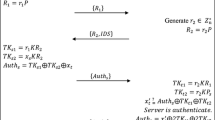Abstract
At RFID’08, Lee et al. have proposed a RFID scheme based on elliptic curve cryptography. This scheme, called Elliptic Curve Random Access Control (EC-RAC) has been conceived in order to be implemented on an efficient security processor designed for RFID tags. The aim of this scheme is to enable a fast, secure and private identification scheme. Security arguments are given to prove that RFID tags implementing this scheme are neither traceable nor cloneable.
We here show how tags can be tracked if one has eavesdropped the same tag twice and we show that a tag can be impersonated if it has been passively eavesdropped three times.
We propose a new scheme based on a modification of the Schnorr scheme as efficient as the initial scheme. We prove that this scheme is zero-knowledge, sound against active adversaries. Moreover, our proposal is private under the Decisional Diffie-Hellman assumption.
This work has been partially founded by the ANR project T2TIT.
Preview
Unable to display preview. Download preview PDF.
Similar content being viewed by others
References
Avoine, G., Buttyán, L., Holczer, T., Vajda, I.: Group-based private authentication. In: Proceedings of the International Workshop on Trust, Security, and Privacy for Ubiquitous Computing (TSPUC 2007). IEEE, Los Alamitos (2007)
Avoine, G., Dysli, E., Oechslin, P.: Reducing time complexity in RFID systems. In: Preneel, B., Tavares, S. (eds.) SAC 2005. LNCS, vol. 3897, pp. 291–306. Springer, Heidelberg (2006)
Batina, L., Mentens, N., Sakiyama, K., Preneel, B., Verbauwhede, I.: Low-cost elliptic curve cryptography for wireless sensor networks. In: Buttyán, L., Gligor, V.D., Westhoff, D. (eds.) ESAS 2006. LNCS, vol. 4357, pp. 6–17. Springer, Heidelberg (2006)
Bellare, M., Palacio, A.: GQ and Schnorr identification schemes: Proofs of security against impersonation under active and concurrent attacks. In: Yung, M. (ed.) CRYPTO 2002. LNCS, vol. 2442, pp. 162–177. Springer, Heidelberg (2002)
Bringer, J., Chabanne, H., Icart, T.: Improved privacy of the tree-based hash protocols using physically unclonable function. In: Ostrovsky, R., De Prisco, R., Visconti, I. (eds.) SCN 2008. LNCS, vol. 5229, pp. 77–91. Springer, Heidelberg (2008)
Feldhofer, M., Dominikus, S., Wolkerstorfer, J.: Strong authentication for RFID systems using the AES algorithm. In: Joye, M., Quisquater, J.-J. (eds.) CHES 2004. LNCS, vol. 3156, pp. 357–370. Springer, Heidelberg (2004)
Fiat, A., Shamir, A.: How to prove yourself: Practical solutions to identification and signature problems. In: Odlyzko, A.M. (ed.) CRYPTO 1986. LNCS, vol. 263, pp. 186–194. Springer, Heidelberg (1987)
Girault, M., Poupard, G., Stern, J.: On the fly authentication and signature schemes based on groups of unknown order. J. Cryptology 19(4), 463–487 (2006)
International Standards ISO/IEC. ISO 14443-3: Identification cards – Contactless Integrated Circuit(s) Cards – Proximity Cards. Part 3: Initialization and Anticollision. ISO (2001)
Jakobsson, M., Sako, K., Impagliazzo, R.: Designated verifier proofs and their applications. In: Maurer, U.M. (ed.) EUROCRYPT 1996. LNCS, vol. 1070, pp. 143–154. Springer, Heidelberg (1996)
Juels, A., Weis, S.A.: Authenticating pervasive devices with human protocols. In: Shoup, V. (ed.) CRYPTO 2005. LNCS, vol. 3621, pp. 293–308. Springer, Heidelberg (2005)
Juels, A., Weis, S.A.: Defining strong privacy for RFID. In: PERCOMW, pp. 342–347. IEEE Computer Society, Los Alamitos (2007)
Van Le, T., Burmester, M., de Medeiros, B.: Universally composable and forward-secure RFID authentication and authenticated key exchange. In: ASIACCS 2007, pp. 242–252. ACM, New York (2007)
Lee, Y.K., Batina, L., Verbauwhede, I.: EC-RAC (ECDLP based randomized access control): Provably secure RFID authentication protocol. In: RFID, pp. 97–104. IEEE, Los Alamitos (2008)
Molnar, D., Wagner, D.: Privacy and security in library RFID: issues, practices, and architectures. In: CCS, pp. 210–219. ACM, New York (2004)
Ohkubo, M., Suzuki, K., Kinoshita, S.: RFID privacy issues and technical challenges 48(9), 66–71 (2005)
Ouafi, K., Phan, R.C.-W.: Privacy of recent RFID authentication protocols. In: Chen, L., Mu, Y., Susilo, W. (eds.) ISPEC 2008. LNCS, vol. 4991, pp. 263–277. Springer, Heidelberg (2008)
Ouafi, K., Phan, R.C.-W.: Traceable privacy of recent provably-secure RFID protocols. In: Bellovin, S.M., Gennaro, R., Keromytis, A.D., Yung, M. (eds.) ACNS 2008. LNCS, vol. 5037, pp. 479–489. Springer, Heidelberg (2008)
Paillier, P., Vergnaud, D.: Discrete-log-based signatures may not be equivalent to discrete log. In: Roy, B. (ed.) ASIACRYPT 2005. LNCS, vol. 3788, pp. 1–20. Springer, Heidelberg (2005)
Schnorr, C.-P.: Efficient identification and signatures for smart cards. In: Brassard, G. (ed.) CRYPTO 1989. LNCS, vol. 435, pp. 239–252. Springer, Heidelberg (1990)
Vaudenay, S.: On privacy models for RFID. In: Kurosawa, K. (ed.) ASIACRYPT 2007. LNCS, vol. 4833, pp. 68–87. Springer, Heidelberg (2007)
Weis, S.A., Sarma, S.E., Rivest, R.L., Engels, D.W.: Security and privacy aspects of low-cost radio frequency identification systems. In: Security in Pervasive Computing, pp. 201–212. Springer, Heidelberg (2003)
Author information
Authors and Affiliations
Editor information
Editors and Affiliations
Rights and permissions
Copyright information
© 2008 Springer-Verlag Berlin Heidelberg
About this paper
Cite this paper
Bringer, J., Chabanne, H., Icart, T. (2008). Cryptanalysis of EC-RAC, a RFID Identification Protocol. In: Franklin, M.K., Hui, L.C.K., Wong, D.S. (eds) Cryptology and Network Security. CANS 2008. Lecture Notes in Computer Science, vol 5339. Springer, Berlin, Heidelberg. https://doi.org/10.1007/978-3-540-89641-8_11
Download citation
DOI: https://doi.org/10.1007/978-3-540-89641-8_11
Publisher Name: Springer, Berlin, Heidelberg
Print ISBN: 978-3-540-89640-1
Online ISBN: 978-3-540-89641-8
eBook Packages: Computer ScienceComputer Science (R0)




